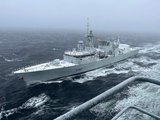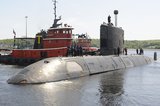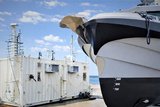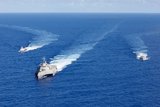Damen introduces MRAV range
Damen has introduced a new range multi-role auxiliary vessels (MRAV) for a range of naval tasks, the company announced on 8 June.
The basic platform is adaptable with supplementary modular mission equipment for various – mainly littoral – naval missions, including explosive ordnance clearance and disposal, diving operations, torpedo recovery and overhaul, ROV and UAV deployment, SAR, coastal infantry and submarine support.
The range of vessels consists of three different designs: the MRAV 660 (43m length), MRAV 1600 (62m length) and MRAV 3600 (85m length).
With a draught of 1.9 metres, the MRAV 660 is suited for very shallow coastal, riverine and inland water operations. It will be positioned for shallow water hydrographic surveys, diving operations, EOCD support, ROV and UAV deployment.
The MRAV 1600 is designed for littoral and regional offshore operations. Its larger size means greater endurance and crew and cargo capacity. In addition to the roles of the MRAV 660 it will be positioned for torpedo recovery and overhaul tasks in support of submarines and anti-submarine warfare units. Small scale coastal transport and infantry support is also possible.
The MRAV 3600 will be capable of operating globally in both littoral and deep waters. It will be configurable for more than one specific mission during a deployment, including serving as a base for disaster and humanitarian relief missions. This vessel also has a helideck and substantial storage capacity for other mission configurations, equipment and cargo.
Piet van Rooij, design and proposal manager, Damen, said: ‘One of Damen’s key aims with this new range of vessels is to reduce the pressure on a navy’s human and financial resources. The modularity of the mission modules also plays a major part in reducing this pressure.
‘We achieved this by combining the capabilities of specialised ships into one ship by using these add-on equipment modules – these can be fitted inside standard 10-, 20- or 40-foot containers or have the footprint of a standard container. When operating multiple ships of the same family and design, the efficiency of training, crew exchangeability and maintenance programmes are improved.’
More from Naval Warfare
-
![How will SAFE shape naval procurement for Canada and its highest-receiving members?]()
How will SAFE shape naval procurement for Canada and its highest-receiving members?
Canada’s inclusion on the EU’s Security Action for Europe initiative is set to enhance the country’s defence procurement strategy with important implications for some of its naval programmes, while Poland and Romania have also secured significant SAFE funding.
-
![Thales wins DE&S contract for portable autonomous command centres]()
Thales wins DE&S contract for portable autonomous command centres
The agreement to provide portable autonomous command centres to the UK Royal Navy will enhance the service’s Mine Counter Measure operations and further integrate autonomous and uncrewed systems into its fleet.
-
![US Navy to conduct an experimentation campaign with emerging tech in 2026 and 2027]()
US Navy to conduct an experimentation campaign with emerging tech in 2026 and 2027
The Technology Operational Experimentation Events will inform future requirements as the US Navy looks for innovative solutions across three key operational domains.





















